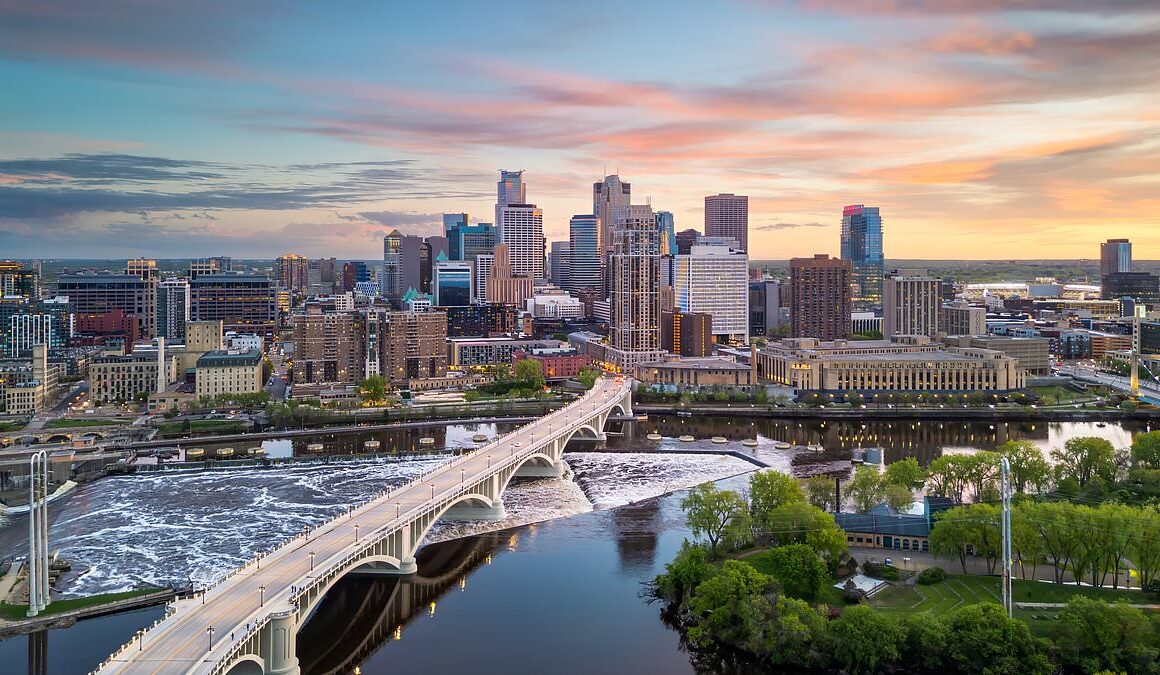Climate change is set to reshape American cities over the next few years as people increasingly abandon flood, heat and wildfire ‘danger zones’ for calmer climes.
Scientists told DailyMail.com that several cities are ‘slowly dying’ due to residents fleeing popular waterside destinations which are prone to flooding – with many metros predicted to look ‘dramatically different’ in just a few decades.
Areas of Minneapolis, Indianapolis, Milwaukee, Providence and Las Vegas are named as the top metro regions forecast to experience the biggest proportional exodus due to flood risk. Meanwhile, relatively ‘safe zones’ such as Jefferson County in Louisville, Kentucky, are seeing an influx of new residents.
Dr Jeremy Porter, who is head of climate implications at First Street Foundation which produced the peer-reviewed report, told DailyMail.com that people are increasingly basing their relocations on climate factors.
‘Over the past five years, people have really started to pay attention to the climate data as something that impacts their moves,’ he said.
‘If you couple flood risk with what we are already seeing from population projections from NASA, we are seeing there are going to be some places that do look dramatically different’.

Climate change is set to reshape American cities over the next few years. Areas of Minneapolis (pictured), Indianapolis, Milwaukee, Providence and Las Vegas are named as the top metro regions forecast to experience the biggest proportional exodus due to flood risk

Scientists told DailyMail.com that several cities are ‘slowly dying’ due to residents fleeing popular waterside destinations which are prone to flooding
Polls back this up. A recent Zillow report found 80 percent of Americans consider climate risks when searching for a new home, while Forbes released a study showing that 30 percent of homeowners say climate change was the reason for their move.
The First Street study identifies America’s top ten ‘climate abandonment areas’ – metro areas where people are leaving in droves due to the increasing risk of climate events disrupting their lives and businesses.

Dr Jeremy Porter is head of climate implications at First Street Foundation
Dr Porter said this first report focuses on flooding only as a driving force – but researchers added that there are definitive signs that wildfires and extreme heat are also major drivers of domestic migration.
Two counties in Minneapolis, Minnesota took first and second place due to their proximity to the Mississippi River which regularly bursts its banks.
Climate change is adding to the problem. A warmer atmosphere means big storms can dump more rain and overwhelm sewer systems.
Researchers identified the Hennepin County and Ramsey County, which cover much of the city center, as areas predicted to have the greatest population decline by 2035.
The number of blocks defined as ‘climate abandonment areas’ in Hennepin County are projected to increased from 23 percent today to 56.9 percent by 2053.
Meanwhile, Ramsey County is set to suffer an increase of 29 percent, bringing the percentage of blocks in the area where people are leaving in droves to 54.3 percent by 2053.
Dr Porter told DailyMail.com these regions are struggling with job losses and fewer resources too – but flooding is accelerating the exodus.

Pictured: A father and son road their bikes on the flooded sidewalks around Lake Nokomis on Sunday June 15, 2014 in Minneapolis

Scientists told DailyMail.com that several cities are ‘slowly dying’ due to residents fleeing popular waterside destinations which are prone to flooding. Areas of Indianapolis (pictured) were named within the top five at-risk areas for climate abandonment in the report

The US was struck by 23 disasters over an eight month period in 2023, which came at a loss of at least $1 billion each (mapped) – eclipsing the previous annual record of 22 events with a 10-figure price-tag in 2022
‘They are already seeing out-migration from lack of jobs and social economical issues. But climate risk is also impacting the moves… Slowly the town is dying,’ he said.
In West Alton, a frequently flood-ravaged town on the bend of the Mississippi River in Ramsey County, the number of residents has nose-dived from 3,900 in 1970 to 360 this year.
All three churches in the town have closed, and many of the remaining homes have been raised on stilts to keep them safe from ever-encroaching floodwaters.
Patrick Nunnally, a retired lecturer at the University of Minnesota and a Mississippi River expert, said towns which were previously thriving on the river are now ‘barely standing’.
The First Street report identified Marion County in Indianapolis as number three in the rankings of counties most negatively impacted by climate out-migration.
The number of blocks defined as ‘climate abandonment areas’ in the county are projected to increase from 15.3 percent today to 39 percent by 2053.
Meanwhile, Milwaukee County in the center of Wisconsin’s biggest city, comes in fourth, followed by Providence County in Rhode Island, and Las Vegas’ Clark County in sixth.
Though some of these cities might seem surprising due to being far from the closest to a major river or coast, Dr Porter explained that they’re prone to ‘pluvial flooding’ caused by rainwater overwhelming sewage systems.

Pictured: Flooding turns roads into rivers in Minneapolis after a torrential rainstorm

A man helps two people walk through flood water after their car got stuck on Vandeventer Avenue underneath I-64 (Hwy. 40) in St. Louis, Mo., on Thursday, July 28, 2022
‘For instance in Las Vegas, you see the patterns on the disconnected streets which are driven by heavy rainfall in the area,’ Dr Porter said.
‘This is especially true in mid-to-large cities where the infrastructure in the area is often under-specced given the fact that the federal government does not include climate change in the storm-water predictions.’
But domestic ‘climate migrants’ tend only to move a few dozen miles to escape extreme weather events.
‘Most moves driven by climate change are hyper local,’ Dr Porter told DailyMail.com. ‘In fact, out of all domestic moves, only 15 percent are across state lines. People tend to stay within their state.’
Meanwhile, as Americans leave certain areas, others are experiencing an influx.
People are flocking to locations like Jefferson County in Louisville, Kentucky; Macomb County in Detroit, Michigan; Newark County in Passaic, New Jersey; Oakland County in Detroit; and San Mateo County in San Francisco, California.
Dr Porter said there are a mix of factors moving people to these places, but mostly its because they’re relatively ‘safe’ zones located close to a climate-risky area where people are fleeing.
The First Street report isolates economic, social and other factors from climate change as the driver of migration by using complex mathematical equations.
But the data translates simply enough – and people are becoming increasingly considering climate risk when they make a move.
‘We are seeing property value decrease in climate risky areas. As the data becomes more and more available, the more we will see this,’ Dr Porter said.
‘The climate knowledge has exploded over the past five years and we are starting to see people responding to that,’ he added. ‘This is just the start.’








